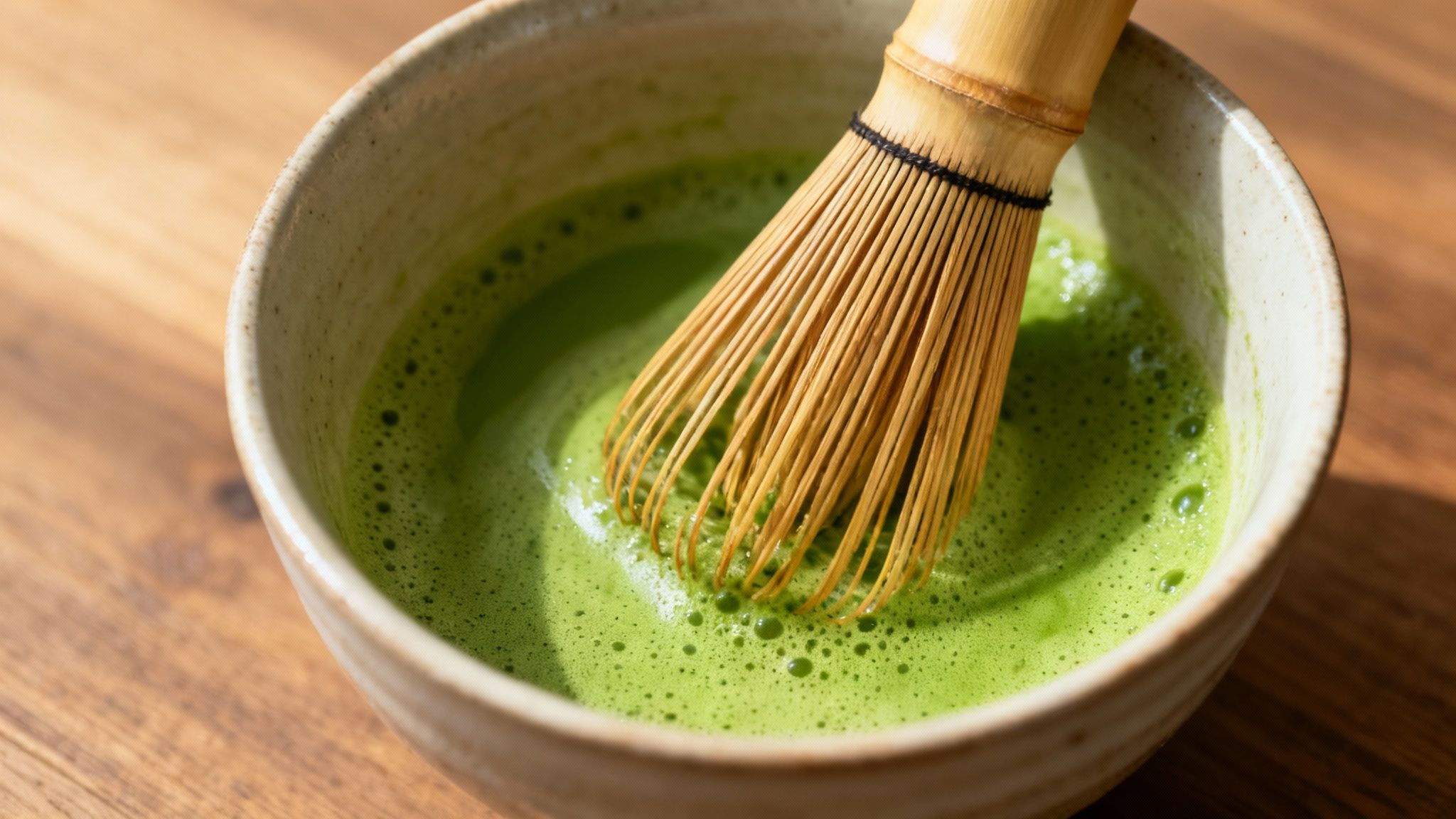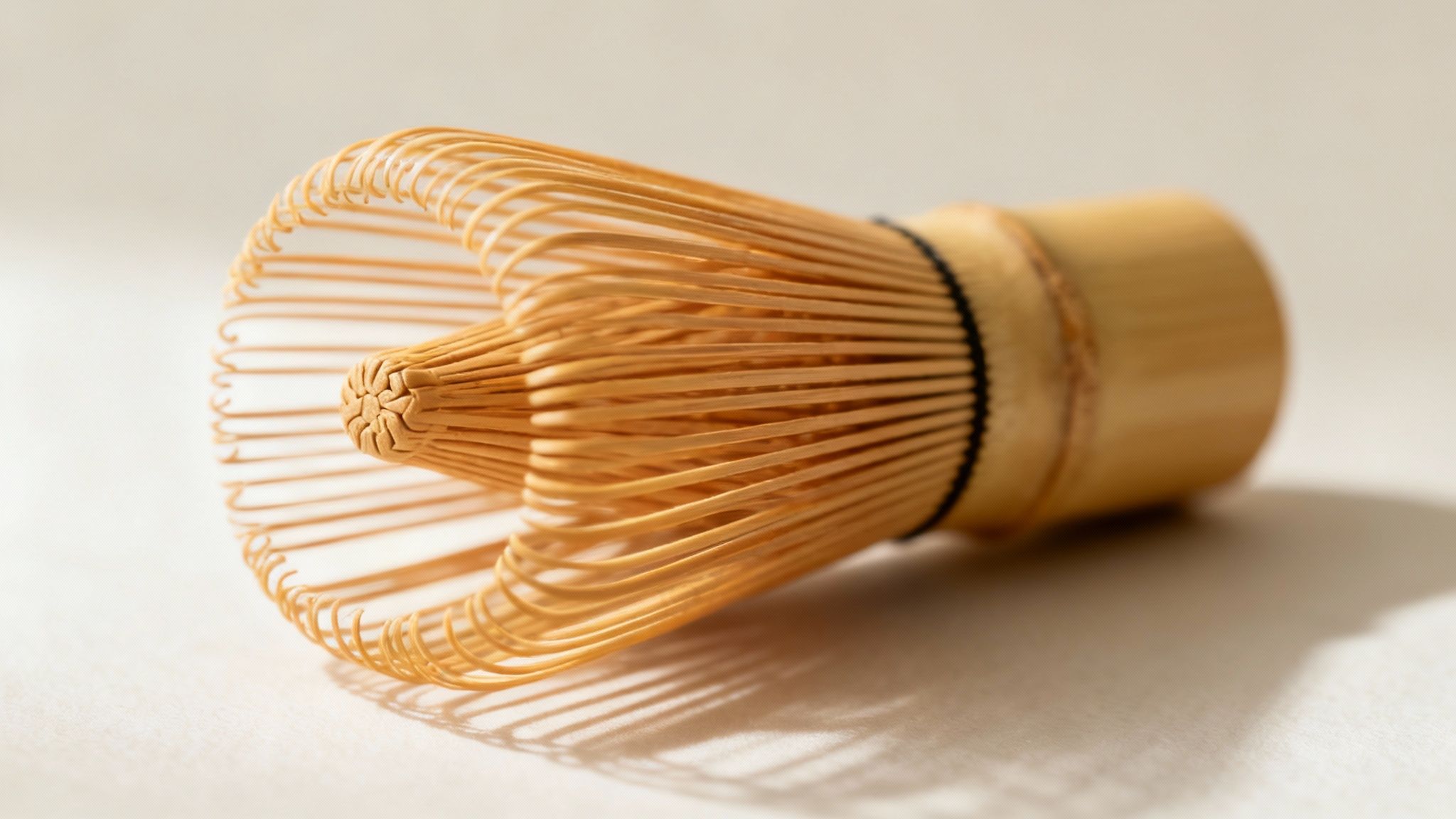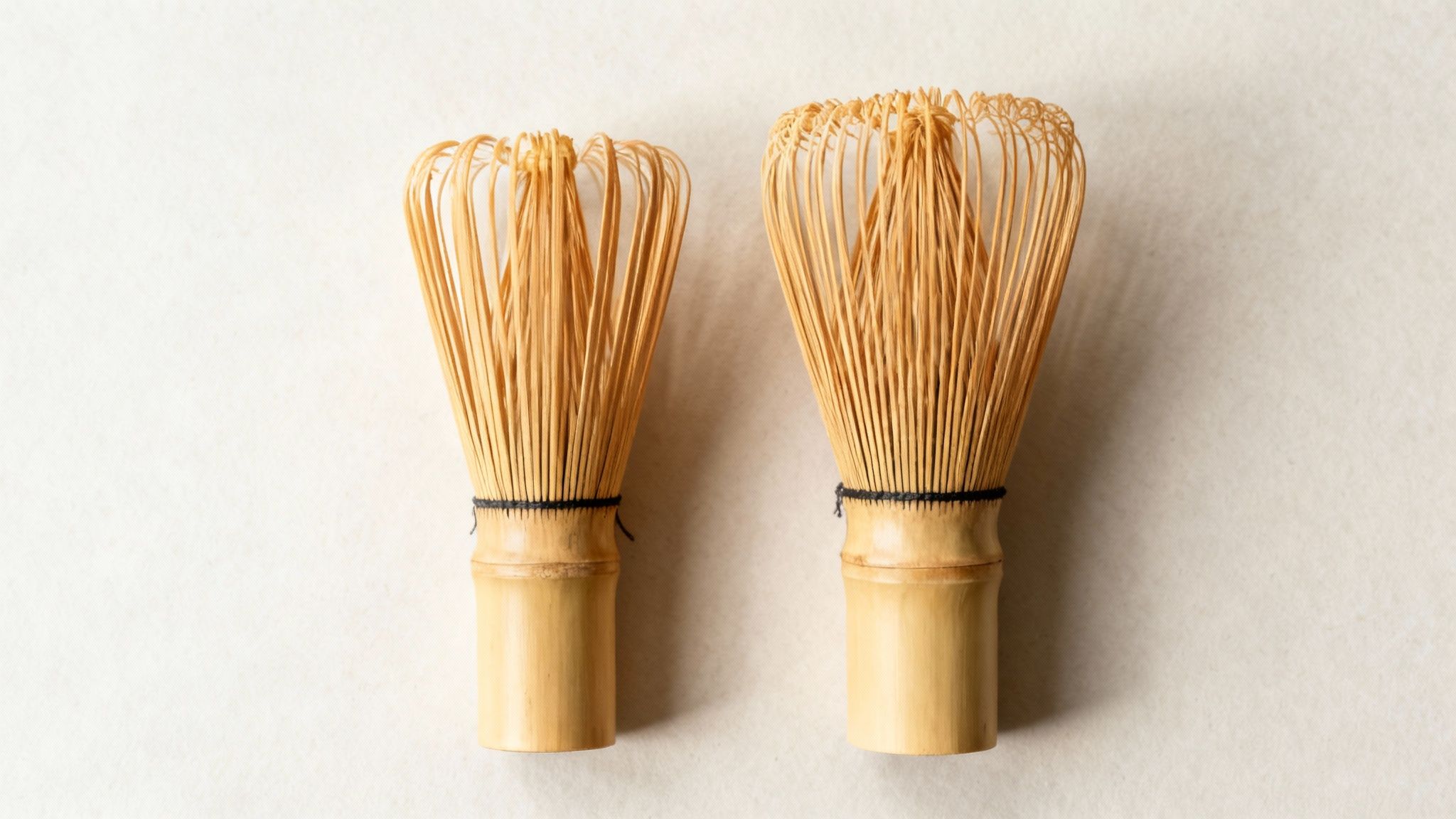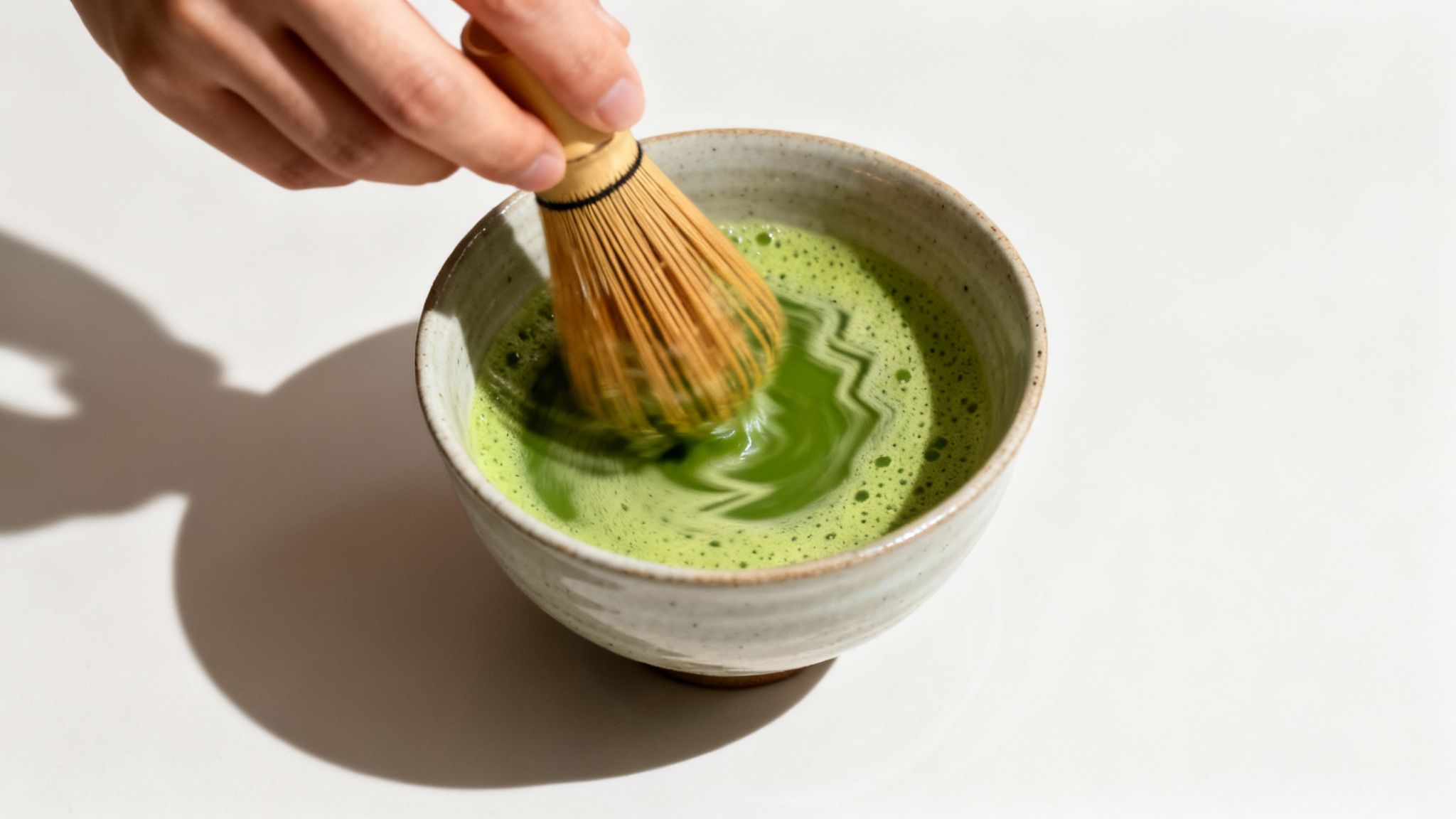When you're first getting into matcha, one of the most essential bits of kit you'll come across is the matcha green tea bamboo whisk, or chasen. It might look like just a beautiful, traditional accessory, but this little handcrafted tool is the absolute key to unlocking that smooth, frothy texture that makes for a perfect cup.
Why a Bamboo Whisk Is Essential for Authentic Matcha
Have you ever tried making matcha at home, only to end up with a lumpy, disappointing brew that’s missing that signature creamy foam? The secret, almost every time, is the whisk. A normal kitchen whisk or one of those electric milk frothers just can't do what a proper chasen does.
The real magic of a bamboo whisk lies in how it’s made. Each one is carefully carved from a single piece of bamboo, with its tip split into dozens of delicate, flexible tines—usually somewhere between 80 and 120 of them. Think of it as a specialised aerator, perfectly designed for one job.
As you whisk back and forth in a quick zig-zag, those fine tines get to work, breaking up any clumps and whipping thousands of tiny air bubbles into the tea. This is what creates that beautiful, stable, and velvety foam—something you simply can’t replicate with anything else.

More Than Just Foam
But it’s not all about the froth. The chasen is steeped in centuries of Japanese tea culture, and using one turns the simple act of making tea into a moment of mindfulness. The focus and deliberate motion connect you to a tradition that goes back generations, making the whole experience much more than just mixing powder and water.
Getting to grips with why this tool is so important is the first real step towards mastering matcha. For anyone serious about their tea, it’s non-negotiable for a few key reasons:
- Proper Aeration: The dozens of fine tines create a far richer and more stable foam than any other tool could manage.
- Unlocking Flavour: The whisking action doesn't just make foam; it fully suspends the matcha powder in the water, unlocking its complex, umami-rich flavour profile.
- The Authentic Experience: Using a chasen is about honouring the cultural heritage of the Japanese tea ceremony.
When you appreciate the purpose behind the whisk, you're not just making a drink; you're taking part in a ritual. This is foundational stuff, especially as you start to explore the different types of matcha tea and learn how their preparation can differ.
Exploring the Artistry of a Bamboo Whisk
At first glance, a matcha whisk seems pretty straightforward. But this humble tool, known as a chasen, is a small marvel of natural engineering. It’s painstakingly handcrafted from just a single piece of bamboo, designed to do a job no other utensil can quite manage: turning fine matcha powder and hot water into a smooth, frothy, vibrant drink.

The real magic is in its construction. Those delicate, flexible prongs at the tip are called the honsaki. Think of them as a tiny, high-speed organic aerator. When you whisk, these tines work together to suspend the tea particles evenly through the water while whipping in air at the same time. This quick, sharp movement is what creates that signature creamy foam – the crema – on top of a perfectly made bowl of matcha.
This isn't just simple stirring. If you tried to use a spoon, you’d end up with clumps of matcha powder at the bottom of the bowl and a gritty, bitter mouthful of tea. The chasen makes sure every single particle is mixed in, unlocking the tea’s full, complex flavour.
The Heart of the Whisk: Bamboo Selection
Not all bamboo is the same, and the type an artisan chooses makes a huge difference to how a whisk performs. The bamboo’s characteristics directly impact the tool's flexibility, durability, and, ultimately, how long it will last. Traditionally, three main types are favoured:
- White Bamboo (Hachiku): This is often used for whisks perfect for beginners. It’s known for being flexible and more affordable.
- Smoked Bamboo (Susudake): A rare and highly prized material. It's often harvested from the ceilings of old Japanese houses, where it’s been naturally smoked over hearths for decades. This process gives it a deep colour and makes it exceptionally durable.
- Black Bamboo (Kurochiku): An elegant, dark bamboo that’s also known for its strength and resilience. It makes for a long-lasting and very effective whisk.
The choice of bamboo is the first sign of real quality. A well-made whisk should feel springy yet strong, with tines that are cut finely and evenly. This attention to detail means the whisk can stand up to regular use and keep producing that perfect, creamy foam.
The world has truly woken up to authentic tea preparation. Matcha is everywhere, with sales of matcha-based drinks jumping by an incredible 202% in just one year. This has naturally brought a greater appreciation for the traditional tools that make it all possible.
This surge in popularity really highlights why it’s worth understanding the tools behind the trend. As more people discover the joy of matcha, the demand for quality bamboo whisks keeps growing, connecting modern tea lovers with a tradition that’s centuries old. You can explore more data behind the matcha obsession to understand its rapid rise.
How to Choose the Right Matcha Whisk

Stepping into the world of matcha means getting acquainted with its most essential tool: the bamboo whisk, or chasen. With so many options out there, picking your first one can feel a little overwhelming, but it all boils down to one key detail: the tine count.
This number, which tells you how many delicate bamboo prongs the whisk has, is far more than just a spec. It’s your guide to the kind of matcha you’ll be making. A higher count creates a denser whisk, perfect for whipping up a fine, delicate foam. A lower count, on the other hand, means a stiffer tool built for much thicker preparations.
Understanding Tine Count and Matcha Style
Most of the whisks you'll come across will have somewhere between 80 and 120 tines. It might not sound like a huge range, but that small difference completely changes how your matcha turns out. It all depends on whether you’re making usucha or koicha.
-
Usucha (Thin Tea): This is the light, frothy matcha that most of us enjoy daily. It uses more water and less powder, and the goal is a lovely, creamy foam. An 80 to 120-tine whisk is your best friend here. Its many flexible prongs are brilliant at whisking air into the tea, creating that signature frothy layer.
-
Koicha (Thick Tea): Reserved for more formal tea ceremonies, koicha is a much thicker, more intense matcha with the consistency of warm honey. For this, you need a whisk with fewer, more robust tines—usually somewhere between 36 and 72. These sturdier prongs are strong enough to knead the matcha powder into a small amount of water without snapping.
Since most of us start our matcha journey with usucha, a whisk with a higher tine count is easily the most versatile and sensible choice for beginners.
If you're looking for a "sweet spot," a whisk with around 100 tines is a fantastic all-rounder. It has the perfect flexibility for a beautiful usucha foam but is still sturdy enough if you decide to dabble in thicker preparations.
Comparing Common Matcha Whisks
To help you picture which whisk is right for your daily ritual, let’s break down how the different tine counts stack up.
Choosing Your Matcha Whisk by Tine Count
Think of this table as a quick guide to finding the perfect bamboo chasen matcha whisk for you.
| Tine Count | Best For (Matcha Type) | Foam Characteristics | Ideal User |
|---|---|---|---|
| 80-Tine | Usucha (Thin Tea) | Creates a good, stable foam with a slightly larger bubble structure. | Excellent for beginners and daily matcha drinkers. |
| 100-Tine | Usucha (Thin Tea) | Produces a very fine, creamy, and delicate foam. A fantastic all-rounder. | Enthusiasts looking for a superior froth and texture. |
| 120-Tine | Usucha (Thin Tea) | The ultimate for froth, creating an exceptionally smooth and velvety foam. | Matcha purists who prioritise the perfect crema. |
| < 72-Tine | Koicha (Thick Tea) | Not designed for foam, but for kneading thick matcha into a paste. | Advanced users participating in formal tea ceremonies. |
Ultimately, choosing the right whisk is about matching the tool to the tea you love to drink.
Beyond the tine count, always have a look at the overall quality. The tines should be evenly spaced, and the central knot that holds them all together should be tied securely. Once you’ve got the right tool in hand, you can start creating the perfect setup for your tea ceremony with diverse kitchen tabletop options.
Your Step-By-Step Guide to Whisking Matcha
This is where the magic really happens. Mastering the whisk turns simple powder and water into a smooth, vibrant, and beautifully frothy drink. With a bit of practice, you’ll find this becomes a soothing and incredibly satisfying daily ritual.

Before you even think about adding the tea, the very first step is to prepare your matcha green tea bamboo whisk. Some people call this 'blooming' the whisk.
It's simple: just stand your chasen in a bowl of warm water for about 30 seconds. This small action softens the delicate bamboo tines, making them far more flexible and less likely to snap while you’re whisking. It's a tiny but essential step to protect your tool and get a smoother result.
The Whisking Process Step-By-Step
With your whisk softened and ready, it’s time to create that perfect foam. This isn't about stirring in circles; it’s a specific, rapid motion that whips air into the tea.
-
Sift Your Matcha: First, sift 1-2 grams (about half a teaspoon) of matcha powder into your tea bowl, or chawan. Sifting is non-negotiable—it breaks up clumps and is your first move towards a silky-smooth texture.
-
Add Hot Water: Pour roughly 60 ml of hot water over the sifted powder. You're aiming for a temperature around 80°C (176°F), which is hot but not boiling. Boiling water will scorch the delicate tea, leaving you with a bitter flavour.
-
The Whisking Motion: Now, grip your bamboo whisk and start moving it back and forth in a quick zig-zag pattern. Imagine you’re rapidly writing the letters ‘M’ or ‘W’. Keep your wrist loose and let it do all the work, not your whole arm.
-
Create the Foam: Keep this motion going for about 15-20 seconds. You'll quickly see a beautiful layer of tiny bubbles forming on the surface. The goal is a thick, creamy foam with no big bubbles left.
-
Finishing Touch: Once you've got a good froth, slow right down and gently draw the whisk in a circle around the edge of the bowl before lifting it from the centre. This neat little trick helps to create a smooth, even surface on your foam.
Remember, the key is that rapid 'M' or 'W' motion. You aren't stirring the matcha; you're whipping it, forcing air into the liquid to create that signature frothy top layer. Your whisk should move through the liquid, not scrape along the bottom of the bowl.
This method ensures every particle of the fine tea powder is perfectly suspended in the water, unlocking its full, rich umami flavour. For a more detailed walkthrough and a few extra tips, our complete guide on preparing matcha tea is an excellent place to start.
To really appreciate the craft behind whisking matcha, it can be fascinating to explore various beverage preparation methods from other worlds, like coffee. While the tools and techniques are completely different, the underlying goal is the same: to draw out the very best flavour from a high-quality ingredient. Once you get the hang of it, this process will give you a perfect, clump-free bowl every single time.
Keeping Your Bamboo Whisk in Perfect Shape
With just a little care, your matcha green tea bamboo whisk, or chasen, can last for years. It’s a surprisingly tough little tool. But neglect it, and you can ruin its delicate prongs in just a few weeks. Looking after your investment is simple, and it starts the second you finish making your tea.
The number one rule? Rinse your whisk straight away. Don't leave it sitting in the bowl. Just a quick run under a gentle stream of warm water, turning it as you go, is enough to wash away any leftover matcha. This stops the tea from drying onto the bamboo, which can make it brittle and a real pain to clean later.
The Golden Rules of Whisk Care
One of the most common mistakes people make is reaching for the washing-up liquid. Never, ever use soap on your chasen. Bamboo is porous, meaning it'll soak up the flavour and chemicals from the soap, and you can bet that’ll end up in your next bowl of matcha. A simple rinse with warm water is all it takes to get it clean.
Once it's rinsed, give it a gentle shake to get rid of the excess water. Whatever you do, don't be tempted to scrub the tines with a sponge or brush – they're far too delicate and you’ll risk breaking them or bending them out of shape.
Proper drying is every bit as important as cleaning. Sticking a damp whisk back in its case or a drawer is the fastest way to invite mould and ruin the shape of the tines for good.
This is where a simple, but absolutely essential, bit of kit comes in.
Why a Whisk Holder Is Non-Negotiable
The real secret to a long and happy chasen life is a ceramic whisk holder, known as a chasen naoshi or kuse naoshi. This small stand might not look like much, but it does two very important things:
- Maintains the Shape: It holds the delicate inner and outer tines in that beautiful, open curl while the whisk dries. Without it, the tines will slowly start to uncurl, and you'll lose that frothing power.
- Promotes Airflow: By holding the whisk upright, the stand lets air get all the way around and through the tines, making sure it dries completely. This is your best defence against the dreaded mould and mildew.
So, after rinsing, just pop your whisk onto the holder and leave it somewhere with good ventilation to air dry. It’s a simple routine that will keep your matcha whisk in perfect nick, ready to whip up a beautiful, frothy bowl of tea time and time again.
Common Matcha Whisking Mistakes to Avoid
Even with the perfect matcha green tea bamboo whisk in hand, a few common slip-ups can stand between you and a perfect bowl of matcha. The good news is they’re easy to spot and fix, saving you from any early frustration.
One of the biggest culprits is using water that’s simply too hot. Pouring boiling water straight from the kettle onto delicate matcha powder is a cardinal sin in the tea world. This intense heat actually scalds the finely ground leaves, leaving you with a bitter, harsh flavour that completely overpowers the matcha’s beautiful sweetness and umami notes.
Protecting Your Whisk and Your Tea
Another easy mistake to make is applying far too much pressure when whisking. A lot of beginners press the chasen firmly into the bottom of the bowl, grinding it around. This heavy-handed approach not only risks snapping the delicate bamboo tines but also stops you from creating that lovely, velvety foam you’re looking for.
Remember, the goal is to whip air into the liquid, not to scrape the bowl. The motion should feel light and energetic, all coming from the wrist, with the whisk suspended in the tea itself.
To avoid these pitfalls, a few simple tweaks to your technique will protect your tools and perfect your tea.
- Cool Your Water: Once your kettle has boiled, just let it sit for a minute or two. You’re aiming for a temperature of around 80°C. A handy trick is to pour the hot water into a separate cup first – this simple transfer will cool it down just enough.
- Use a Light Touch: Your whisking motion should be a quick, brisk zig-zag, almost like you’re writing the letter 'M' or 'W' over and over. The tips of the tines should barely graze the bottom of the bowl.
- Proper Storage is Key: Whatever you do, don't put a damp whisk back in its plastic container. This traps moisture and is a fast track to mould, which will ruin the bamboo. Always let it air dry completely on a proper whisk holder to help it keep its shape and stay clean.
A Few Final Questions
We get asked a lot of questions about matcha whisks, so let's run through a few of the most common ones to clear things up.
Can I Make Matcha Without a Bamboo Whisk?
You can certainly try. Some people reach for an electric frother or even give it a good shake in a jar, but the results are never quite the same. Only a traditional bamboo whisk has the right design to properly suspend the fine powder in water.
Anything else tends to leave you with a lumpy, less flavourful brew. For the authentic experience, a proper chasen is essential.
When Should I Replace My Matcha Whisk?
A well-looked-after chasen is a surprisingly sturdy tool. You'll know it's time for a new one when a good number of the tines have snapped off or if the central knot starts to come undone.
If you’re a daily matcha drinker, you might find yourself needing a replacement once a year. For more occasional use, a single whisk could easily last you several years.
Is a Special Whisk Holder Really Necessary?
In a word, yes. We can’t recommend a whisk holder (chasen naoshi) enough. It’s the key to helping the delicate bamboo tines keep their elegant curl as they dry, stopping them from straightening out and losing their whisking power.
A holder also lets air circulate freely around every part of the whisk. This is crucial for preventing mould and will dramatically extend the life of your chasen, protecting your investment.
Proper storage is every bit as important as proper cleaning when it comes to keeping your whisk in perfect shape.
Discover the difference a quality whisk makes. Explore the authentic matcha tools at Jeeves & Jericho and elevate your tea ritual. Shop now.


